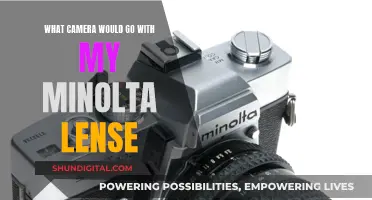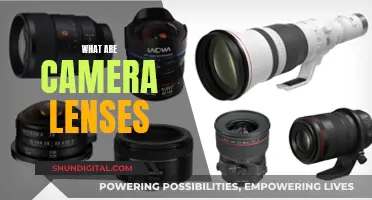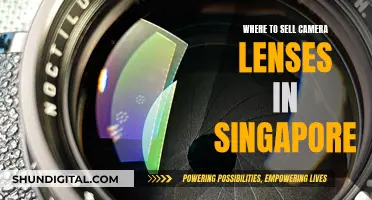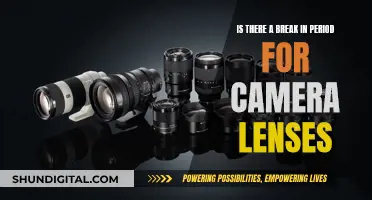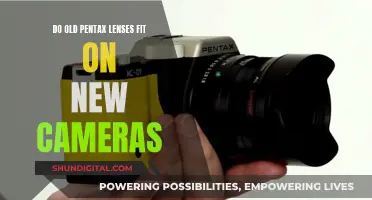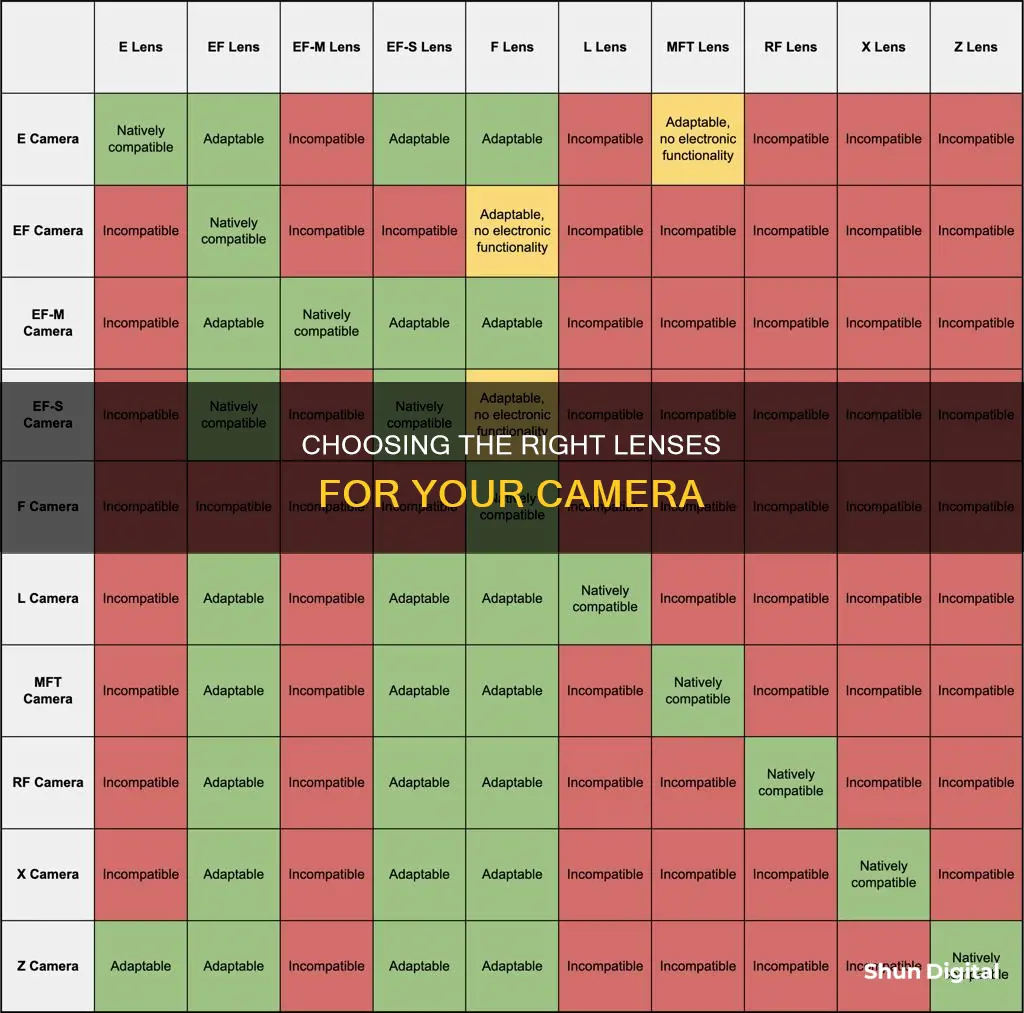
Choosing the right lens for your camera is an important step in elevating your photography to the next level. The first step in determining lens compatibility is to identify your camera model and understand what mount your camera has. The mount is the part of the camera where the lens clicks into place, and different brands often use different types of mounts. Canon, for example, uses the EF mount, while Nikon uses the F mount, and Sony uses the E mount. Once you know your camera's mount, you can then find out the mount of the lens you're considering. If you have a mirrorless body, you can adapt any DSLR lens to it. Additionally, if you have an APS-C body, you can use both lenses made for APS-C and full-frame, but if you have a full-frame body, you can only use lenses made for full-frame. It's also important to keep in mind that using adapters can sometimes limit lens functions, such as autofocus or manual adjustments.
| Characteristics | Values |
|---|---|
| Camera type | DSLR, mirrorless, APS-C, full-frame |
| Lens type | EF, EF-S, M, R, etc. |
| Lens mount | Canon EF mount, Nikon F mount, Sony E mount |
| Sensor size | APS-C, full-frame |
| Adapter | Required if lens and camera mount don't match |
What You'll Learn

Understand lens mounts and how they work
Lens mounts are the junction where your camera meets the lens. Different camera brands often use different types of mounts. Canon, for instance, uses the EF mount, Nikon uses the F mount, and Sony uses the E mount. These mounts are like a unique language that each camera brand speaks, determining which lenses can directly fit your equipment.
Lens mounts are usually located on the front of your camera. Canon cameras have four mount types. You can identify the type of mount by looking at the lens mount index on the front of your EOS camera. If you see a red line on the lens mount, your camera is an EOS APS-C R System or EOS Full-frame R System mirrorless. A red circle and a white square indicate an EOS APS-C DSLR, while a red circle on its own indicates an EOS full-frame DSLR. Finally, a white circle on the lens mount means your camera is an EOS M series APS-C mirrorless.
The type of mount affects the compatibility of the lens with your camera. When buying a new lens, the first thing to check is whether its mount matches your device. If you have a Canon camera, you’ll generally need a lens with a Canon EF mount.
Adapters can be used to attach a lens to a camera with an incompatible lens mount. Adapters are like translators, allowing lenses and cameras from different brands to work together. However, they can sometimes limit lens functions, such as autofocus or aperture control, and the fit might not be as secure.
If you're buying a third-party lens, you'll want to ensure it works for both your camera's mount and the sensor size. Most individual third-party lenses are available in DSLR or mirrorless mounts, and are designated as either full-frame or APS-C.
If you have a mirrorless body, you can adapt any DSLR lens to it. If you have an APS-C body, you can use both lenses made for APS-C and full-frame cameras. However, if you have a full-frame body, you can only use lenses made for full-frame cameras, as an APS-C lens projects a smaller image due to its smaller sensor.
The crop factor refers to the difference in sensor size compared to a 35mm film frame. It affects the effective focal length of lenses, which in turn affects the frame size. For example, a 50mm lens on a camera with a 1.5x crop factor will behave like a 75mm lens.
In summary, the key to lens compatibility lies in the camera mount. Camera bodies and lenses are designed with specific mounts, which determine whether a lens can physically fit and communicate with the camera body. Adapters can be used to attach lenses with different mounts, but they may limit functionality. When choosing a lens, it's important to consider your camera type and what you plan to photograph.
Understanding Camera Lenses: Measuring for Perfect Photos
You may want to see also

Know your camera's mount
The mount is the part of your camera where the lens clicks into place. Different brands often use different types of mounts. Canon, for example, uses the EF mount, Nikon uses the F mount, and Sony uses the E mount. These mounts are like a unique language that each camera brand speaks, and they determine which lenses can directly fit onto your equipment.
The type of mount affects the compatibility of the lens with your camera. So, when looking for a new lens, the first thing to check is whether its mount matches your device. If you have a Canon camera, you’ll generally need a lens with a Canon EF mount, and so on.
The easiest way to find out which lenses your camera will accept is to look at the lens mount index on the front of your camera. Canon cameras, for instance, have four mount types:
- EOS APS-C R System or EOS Full-frame R System mirrorless (red line on the lens mount)
- EOS APS-C DSLR (red circle and white square on the lens mount)
- EOS full-frame DSLR (red circle on the lens mount)
- EOS M series APS-C mirrorless (white circle on the lens mount)
Lens mounts are written in letters such as EF, EF-S, M, and R. If you have a mirrorless body, you can adapt any DSLR lens to it. If you have an APS-C body, you can use both lenses made for APS-C and full-frame. However, if you have a full-frame body, you can only use lenses made for full-frame, not APS-C.
Adapters can be used to connect a lens to a camera despite an incompatible lens mount. However, they can sometimes limit lens functions. For example, your lens might not focus as quickly, or you might have to adjust settings manually. Also, the fit might not always be as secure as a lens that matches your camera’s mount directly.
If you're buying a new lens, try to ensure that you don't need an adapter. If you're buying a lens for a specific camera, it's best to purchase an adapter from the camera manufacturer to guarantee that the electronics in the lens will work with the camera.
Projector Lenses: Can They Double as Cameras?
You may want to see also

Know your camera's sensor type
Knowing your camera's sensor type is essential for choosing the right lenses and achieving the desired image quality. Sensors are made up of tiny individual photosites that capture light and convert it into an electrical signal, which is then processed to create a digital image. The size and type of your camera's sensor will have a significant impact on your images.
There are two main types of electronic image sensors: the charge-coupled device (CCD) and the active-pixel sensor (CMOS). CCD sensors were the first to be used in digital cameras and are known for their high image quality. However, they tend to be more expensive and power-intensive. On the other hand, CMOS sensors are more commonly found in consumer goods as they are cheaper, more energy-efficient, and have faster readout speeds.
When it comes to sensor size, the larger the sensor, the higher the image quality. Full-frame sensors, which have the same dimensions as 35mm film, are the preferred choice for professional photographers. They offer better low-light performance, reduced noise, and a wider dynamic range. However, they are typically more expensive. APS-C sensors are the most versatile and are used by both beginners and professionals. They are smaller and more affordable but may not deliver the same image quality as full-frame sensors.
It's important to note that not all lenses are compatible with all sensor sizes. A full-frame lens will work on a camera with a smaller sensor, but the image will appear zoomed-in. On the other hand, using an APS-C lens on a full-frame camera will result in reduced resolution and a cropped image. Therefore, it's crucial to consider both the mount type and the sensor size when choosing lenses for your camera.
Camera Lenses: Understanding Their Value and Depreciation Over Time
You may want to see also

Learn about adapters and their limitations
Adapters are a handy solution for photographers who want to use a lens with a camera body that it wasn't designed for. They can bridge the gap between incompatible interfaces, enabling different systems to work together. In the context of cameras, adapters are physical connectors that allow photographers to attach lenses from one system to a camera body from another.
Adapters have their limitations, however. While it's simple to adapt DSLR lenses to a mirrorless camera body, it's difficult, or often impossible, to go in the other direction. For example, you can attach older Canon EF lenses (designed for DSLRs) to Canon's R-series mirrorless bodies with a simple adapter and almost no penalty in performance. But a native mirrorless RF lens won't work on a DSLR body. The mirrorless lens would be too close to the sensor in a DSLR camera, and this would seriously limit the range in which it could focus.
Another limitation of adapters is that they can't change the image circle projected by a lens. Full-frame lenses will work on cameras with smaller sensors, but the image will appear zoomed-in compared to what you'd get with a full-frame camera. This is because the smaller sensor captures a smaller portion of the lens's image circle.
Adapters can be a useful tool for photographers, but it's important to understand their limitations and buy lenses that are compatible with your camera body to ensure optimal performance.
What Shape Makes Camera Lenses Work?
You may want to see also

Research your camera's compatible lenses
The first step to finding out which lenses are compatible with your camera is to identify your camera model. This information is typically found on the camera body. Once you have this information, you can consult the user manual or the manufacturer's website to look up a list of compatible lenses. Alternatively, you can search for your camera model on the B&H Photo Video website, which provides information on lens compatibility.
Understanding camera mounts
Lens mounts are the junction where your camera meets the lens. Different brands often use different types of mounts, which are like the unique 'language' each camera brand speaks. Canon, for example, uses the EF mount, Nikon uses the F mount, and Sony uses the E mount. These mounts determine whether a lens can physically fit and communicate with your camera.
Adapters
If you want to use a lens from a different brand, you can use an adapter. Adapters are like translators – they let lenses and cameras from different brands work together. However, using adapters may limit lens functions. For example, your lens might not focus as quickly, or you might have to adjust settings manually. The fit might not always be as secure as a lens that matches your camera’s mount directly.
Third-party lenses
Third-party lens manufacturers such as Sigma, Tamron, and Zeiss offer high-quality lenses that are often more affordable than those from camera manufacturers. However, it is important to ensure that the lens is designed for your camera's mount before purchasing.
Crop factor
Your camera's crop factor affects the effective focal length of lenses, which in turn affects the frame size. For example, a 50mm lens on a camera with a 1.5x crop factor behaves like a 75mm lens. While it doesn't affect physical compatibility, it changes how the lens will perform on your camera.
Camera Lenses: Flattering or Distorting Reality?
You may want to see also
Frequently asked questions
The compatibility of a lens with your camera depends on the lens mount. The lens mount is the part of the camera where the lens clicks into place. Different brands use different types of mounts, so you need to ensure the lens mount matches your camera. Canon cameras, for example, use the EF mount, while Nikon uses the F mount, and Sony uses the E mount.
Adapters can be used to connect lenses and cameras from different brands. However, using an adapter may limit the functionality of the lens, such as slower autofocus or the need for manual adjustments.
DSLRs have a mirror inside, whereas mirrorless cameras do not. The mirror in a DSLR camera sits behind the lens and flips up and down to allow the shooter to see through the viewfinder.
A full-frame camera uses a sensor that is the same size as an image shot on 35mm film. A camera with a smaller sensor is likely to be an APS-C camera, which has a sensor that is roughly 25% smaller than a full-frame sensor.


